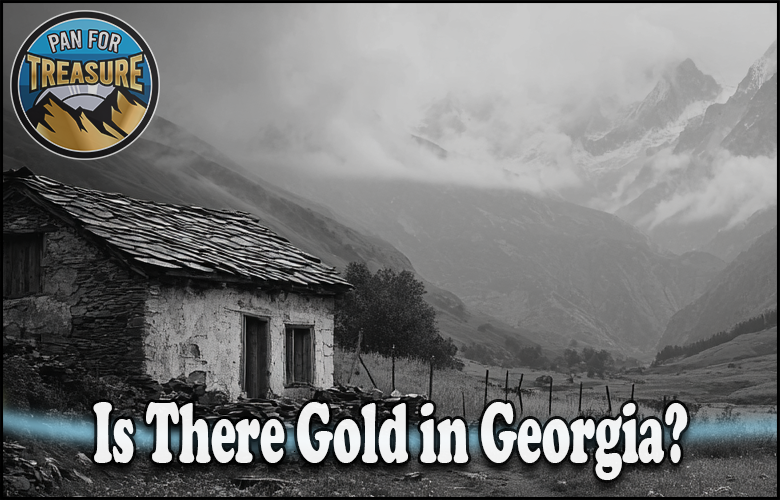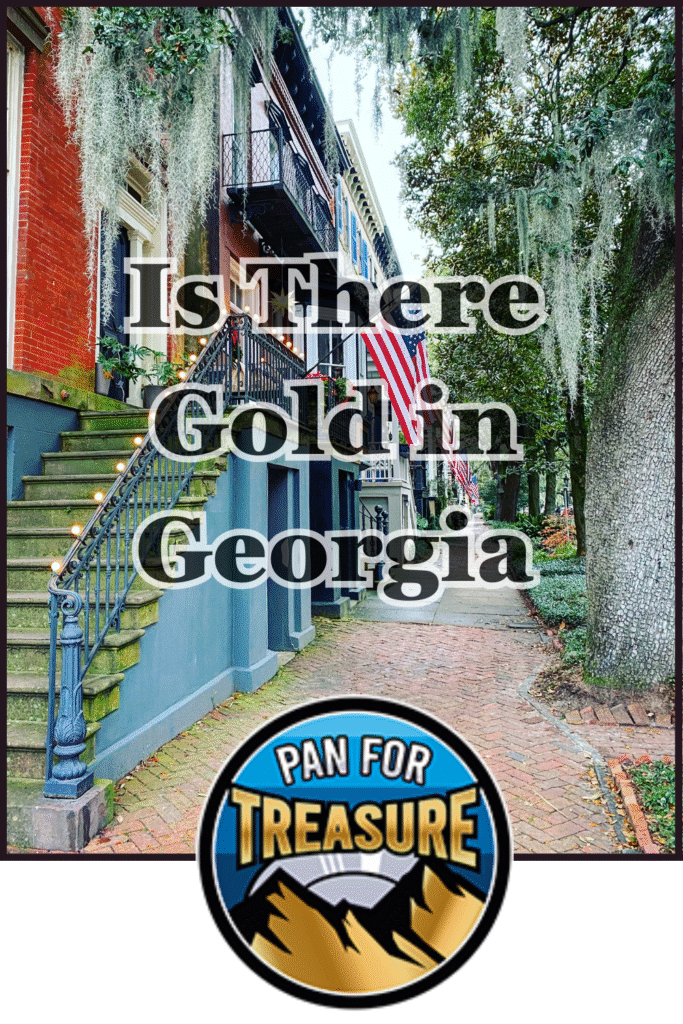
Disclosure: This Post Contains Affiliate Links; We earn a commission on purchases.
Is there gold in Georgia? Absolutely! Georgia boasts a fascinating history of gold mining, dating back to the Georgia Gold Rush of the 1820s.
The state is home to the Georgia Gold Belt, a region stretching from eastern Alabama to Rabun County, where some of the largest gold deposits in the eastern United States were discovered.
With rich veins of nearly 24-karat gold often found mixed with quartz, areas like White, Lumpkin, and northern Cherokee counties became hotspots for prospectors.
The Dahlonega District, in particular, remains a treasure trove of quartz veins and gold deposits, captivating gold mining enthusiasts to this day.
Key Takeaways:
- Georgia is home to the Georgia Gold Belt, which contains the largest quantities of gold found in the eastern United States.
- The Georgia Gold Rush in the 1820s led to the establishment of historic cities like Auraria and Dahlonega.
- Dahlonega, in particular, was at the heart of the gold rush and offers visitors the chance to explore old gold mines like Consolidated Gold Mines and Crisson Gold Mines.
- Recreational gold panning is allowed in many streambeds in Georgia, making it a popular activity for both locals and tourists.
- The influx of miners during the Georgia Gold Rush had a devastating impact on Native Americans, particularly the Cherokee Nation and the forced removal known as the Trail of Tears.
Is There Gold in Georgia?
Yes, there is gold in Georgia! The state’s rich gold mining history dates back to 1828, when the first gold rush in the United States began in North Georgia.
This discovery, made years before the California Gold Rush, put Georgia on the map as a hotspot for gold-bearing deposits.
The Georgia Gold Belt, stretching across the northern part of the state, became a magnet for prospectors eager to strike it rich.
Even today, traces of gold can still be found in Georgia’s rivers, streams, and historic mining sites.
Whether you’re panning for gold in the picturesque waterways or exploring the remnants of old mines, Georgia offers a unique opportunity to uncover its glittering past.
For adventurers and history enthusiasts alike, the answer to “Is there gold in Georgia?” is a resounding yes!
Georgia Gold Rush and Historic Cities
The discovery of gold in the Georgia Gold Belt in 1828 sparked the Georgia Gold Rush, attracting prospectors from near and far.
This wave of gold fever brought significant changes to the region, transforming small settlements into bustling cities. Two such historic cities that thrived during this time were Auraria and Dahlonega.
Auraria, located in Lumpkin County, Georgia, was one of the first gold mining towns in the state. It boomed in the 1830s, with a population surpassing 10,000 people at its peak.
However, as the gold rush waned, the town declined, and many of its structures were abandoned.
“The historic cities of Auraria and Dahlonega were the primary beneficiaries of the gold discovery.”
Dahlonega, on the other hand, experienced sustained success as a gold mining hub. It became the center of the Georgia Gold Rush and served as the site of a branch mint of the United States Mint from 1838 until 1861.
The Dahlonega Mint produced more than $6 million worth of gold coins during its operation.
The Georgia Gold Belt in which these cities are situated stretches across several counties, including Lumpkin, White, and northern Cherokee.
It is part of a larger zone of gold deposits that extends from eastern Alabama to Virginia.
| City | Established | Peak Population |
|---|---|---|
| Auraria | 1832 | 10,000+ |
| Dahlonega | 1832 | 5,000+ |
The Georgia Gold Rush left a lasting impact on both Auraria and Dahlonega. Today, visitors to these historic cities can explore their gold rush heritage through preserved buildings, museums, and gold mining attractions.
Dahlonega, in particular, is home to the renowned Dahlonega Gold Museum and popular gold mines like Consolidated Gold Mines and Crisson Gold Mines.
Gold Rush Quote:
“The discovery of gold created a frenzy of activity, attracting people from all walks of life to try their luck in the pursuit of wealth and adventure.”
Next, we’ll dive deeper into the history of gold mining in Dahlonega, uncovering the stories of the miners and the techniques they used to extract gold from the earth.
Gold Mining in Dahlonega
Dahlonega, located in Lumpkin County, Georgia, played a central role in the Georgia Gold Rush. The area is situated on top of the largest gold deposits east of the Mississippi River, with gold first discovered in 1828.
Today, visitors have the opportunity to immerse themselves in the rich history of gold mining in Dahlonega.
One notable attraction is the Dahlonega Gold Museum, where visitors can learn about the fascinating gold mining history of Georgia.
The museum showcases exhibits that delve into the techniques, tools, and stories of the miners who sought their fortunes in the region. It provides a captivating glimpse into the challenges and successes of the gold mining industry.
For those looking to experience gold mining firsthand, there are a few options to explore. Consolidated Gold Mines offers underground tours that take visitors deep into the tunnels and chambers where miners once toiled.
Visitors can witness the impressive engineering feats and learn about the harsh working conditions faced by the miners.
Crisson Gold Mines is another popular destination for gold mining enthusiasts. The mine offers guided tours that provide a glimpse into the mining process and the chance to try panning for gold in their onsite troughs.
It’s an exciting activity that allows visitors to connect with the past and potentially find a glimmer of gold.
Discover the Legacy of Gold Mining in Dahlonega
“Dahlonega’s gold mining history is an essential part of Georgia’s heritage. The stories of the brave miners who sought their fortunes here, the hardships they faced, and the impact they had on the region are truly captivating.”
Visiting the Dahlonega Gold Museum and exploring the old gold mines offers a unique and immersive experience.
It allows visitors to gain a deeper appreciation for the individuals who dedicated their lives to uncovering the precious metal that shaped the history of Georgia.
Whether you’re a history enthusiast or simply seeking a memorable adventure, Dahlonega’s gold mining sites are sure to leave you with a newfound appreciation for the remarkable stories of the past.
Gold Panning in Georgia
Recreational gold panning is a popular activity in Georgia, allowing individuals to try their hand at finding gold without the need for special permits or permissions.
As long as only a shovel and pan are used and no significant damage is done to the streambed, anyone can engage in this exciting adventure.
The state of Georgia offers a variety of gold panning locations, where enthusiasts can explore its rich history and potentially discover valuable treasures. Some of the popular gold panning locations in Georgia include:
- Chattahoochee River
- Chestatee River
- Little River
These picturesque rivers provide ideal conditions for recreational gold panning, with their flowing waters and potential gold deposits.
Visitors can immerse themselves in the serenity of nature while partaking in the thrilling endeavor of searching for gold.
To enhance your experience, remember to bring basic gold panning equipment, such as a shovel and pan.
With patience and persistence, you can engage in a recreational activity that connects you to Georgia’s rich gold mining heritage.
Discover Georgia’s Golden Heritage
“Recreational gold panning allows you to connect with Georgia’s golden heritage and experience the thrill of finding gold firsthand.” – Local gold panning enthusiast
Gold Mining Techniques and Methods
During the Georgia Gold Rush, miners employed a range of techniques to extract gold from the ground. Initially, placer mining was the most prevalent method used by miners.
This technique involved collecting gold particles from deposits in streams and rivers.
As the easily accessible gold became scarce, miners shifted their focus to hard-rock mining. This method required digging tunnels to access gold veins inside mountains and crushing the ore to release the gold.
Hard-rock mining proved to be more labor-intensive and challenging than placer mining but yielded higher quantities of gold.
Other more efficient methods were also employed during this period. Miners utilized tools like sluice boxes, which used flowing water to separate gold particles from other sediments.
Stamp mills were another common tool used in gold mining. These mills crushed rocks into fine particles, allowing for the extraction of gold.
“Hard-rock mining required immense perseverance and determination. Miners faced tough working conditions but were driven by the possibility of striking gold.”
The Pros and Cons of Gold Mining Techniques
Each gold mining technique had its advantages and disadvantages. Placer mining was relatively easy to learn and required minimal investment, making it accessible to many individuals.
On the other hand, it relied on the availability of placer deposits, which could be exhausted quickly.
Hard-rock mining, while more complex and costly, offered the potential for higher yields. However, it demanded substantial capital investment, technical expertise, and access to mineral-rich areas.
Despite the challenges, the allure of finding substantial gold deposits motivated miners to persevere.
Comparison of Placer Mining and Hard-Rock Mining
| Placer Mining | Hard-Rock Mining |
|---|---|
| Relatively easy to learn | Complex and required technical expertise |
| Minimal investment | Substantial capital investment |
| Access to placer deposits required | Access to mineral-rich areas required |
| Potential for lower yields | Potential for higher yields |
Gold Mining in Georgia’s History
The Georgia gold industry has a rich history marked by waves of excitement and revival. After the initial gold rush, which brought a surge of prospectors and settlers to the region, the industry continued at a reduced level until the outbreak of the Civil War.
However, it experienced a major revival between 1899 and 1906, with renewed interest in gold mining. Additionally, there were additional minor episodes of gold excitement during the early to mid-twentieth century.
The Dahlonega area, which was at the heart of the initial gold discovery, still bears remnants of this storied history.
These historical remnants contribute to the area’s heritage tourism, attracting visitors eager to explore the fascinating past of the Georgia gold industry.
Today, visitors can witness the legacy of the Georgia gold industry by exploring the remnants of old gold mines, visiting museums dedicated to Georgia’s gold mining history, and immersing themselves in the heritage of the Dahlonega area.
| Period | Description |
|---|---|
| 1828-1861 | The Georgia Gold Rush and the operation of a branch mint in Dahlonega |
| Late 19th century – early 20th century | Major revival with increased production and renewed interest in gold mining |
| Early to mid-20th century | Additional minor episodes of gold excitement |
The table above provides a concise summary of the waves of gold excitement and revival in Georgia’s gold mining history.
Tips for Successful Gold Prospecting in Georgia
Long before the California Gold Rush captured the nation’s attention, Georgia was the site of the first gold rush in the United States.
In 1828, Benjamin Parks stumbled upon gold-bearing rocks in North Georgia, sparking a frenzy that would forever change the region.
This discovery, east of the Mississippi River, marked the beginning of a historic era as thousands flocked to the area, hoping to strike it rich.
North Georgia quickly became a hub for gold mining, with prospectors panning for gold in its rivers and streams.
The region’s gold-bearing deposits fueled the dreams of fortune seekers and solidified Georgia’s place in mining history.
Today, the legacy of this first gold rush lives on, offering visitors a chance to connect with the past and experience the thrill of gold panning for themselves.
Gold Panning FAQs for Georgia
Is there gold in Georgia rivers?
Yes, Georgia rivers like the Chattahoochee River, Etowah River, and Chestatee River are known to contain gold. These waterways were at the heart of the first major U.S. gold rush in the early 1800s.
Is there gold in Georgia creeks?
Georgia creeks, especially those in Lumpkin and White Counties, have long been popular for placer gold. Yahoola Creek, Dukes Creek, and Cane Creek are well-known panning spots that continue to produce small gold flakes.
Is there gold in Georgia streams?
Yes, many streams in northern Georgia still carry gold from historic deposits. Slow-moving water and gravel bars are prime areas to pan in places like the Blue Ridge region and near Dahlonega.
Is there gold in Georgia today?
Recreational gold panning is still very popular in Georgia, and hobbyists often find small gold pieces. Many locations even offer pay-to-pan setups where beginners can try their luck.
Where can I pan for gold in Georgia?
Top gold panning sites in Georgia include Consolidated Gold Mine and Crisson Gold Mine in Dahlonega, Dukes Creek Gold & Ruby Mine, and several public-access creeks in the Chattahoochee National Forest. Always check land access and rules before prospecting.
{
“@context”: “https://schema.org”,
“@type”: “FAQPage”,
“mainEntity”: [
{
“@type”: “Question”,
“name”: “Is there gold in Georgia rivers?”,
“acceptedAnswer”: {
“@type”: “Answer”,
“text”: “Yes. Georgia rivers like the Chattahoochee River, Etowah River, and Chestatee River are known to contain gold. These waterways were central to the first major U.S. gold rush in the early 1800s.”
}
},
{
“@type”: “Question”,
“name”: “Is there gold in Georgia creeks?”,
“acceptedAnswer”: {
“@type”: “Answer”,
“text”: “Yes. Creeks in Lumpkin and White Counties, such as Yahoola Creek, Dukes Creek, and Cane Creek, have long been popular for placer gold and still produce small gold flakes.”
}
},
{
“@type”: “Question”,
“name”: “Is there gold in Georgia streams?”,
“acceptedAnswer”: {
“@type”: “Answer”,
“text”: “Yes. Many streams in northern Georgia still carry gold from historic deposits. Slow-moving water and gravel bars are prime areas to pan in the Blue Ridge region and near Dahlonega.”
}
},
{
“@type”: “Question”,
“name”: “Is there gold in Georgia today?”,
“acceptedAnswer”: {
“@type”: “Answer”,
“text”: “Yes. Recreational gold panning is still popular in Georgia, and hobbyists often find small pieces. Many locations also offer pay-to-pan experiences for beginners.”
}
},
{
“@type”: “Question”,
“name”: “Where can I pan for gold in Georgia?”,
“acceptedAnswer”: {
“@type”: “Answer”,
“text”: “Top gold panning sites include Consolidated Gold Mine and Crisson Gold Mine in Dahlonega, Dukes Creek Gold & Ruby Mine, and several public-access creeks in the Chattahoochee National Forest. Always check land access and rules before prospecting.”
}
}
]
}
Conclusion
The Georgia Gold Rush has left an enduring legacy, shaping the state’s history and the growth of cities like Dahlonega.
The discovery of gold in the Georgia Gold Belt during the early 1800s sparked a wave of excitement, drawing thousands of miners in search of fortune.
While the easily accessible deposits have been mined out, the spirit of the gold rush lives on.
Visitors can still experience the thrill of gold panning in Georgia’s picturesque streams and rivers or explore its rich history through museums like the Dahlonega Gold Museum and historic sites such as Consolidated Gold Mines and Crisson Gold Mines.
Whether you’re seeking adventure or a deeper connection to the past, one thing remains clear-if you’re wondering, is there gold in Georgia? The answer is a resounding yes, both in its history and its timeless appeal.
Source Links
- https://en.wikipedia.org/wiki/Georgia_Gold_Belt
- https://www.dahlonega.org/things-to-do/gold-mining/
- https://dlg.usg.edu/collections/dlg_dahl/history


Meet Ryan Conlon, the passionate owner and driving force behind Pan for Treasure.
With an unwavering love for the art of gold panning, Ryan has transformed his enthusiasm into a thriving community hub for fellow treasure seekers. [email protected]
A seasoned gold panning enthusiast, Ryan’s journey began with a simple pan and a dream, evolving into a deep appreciation for the history, geology, and thrill of uncovering precious metals.
Subscribe to Our Newsletter
